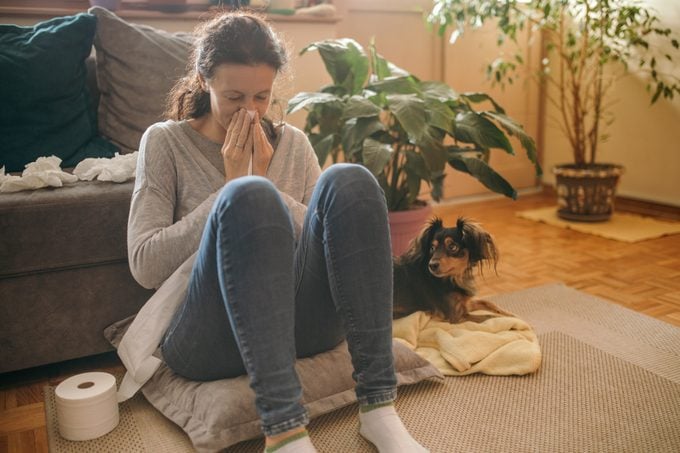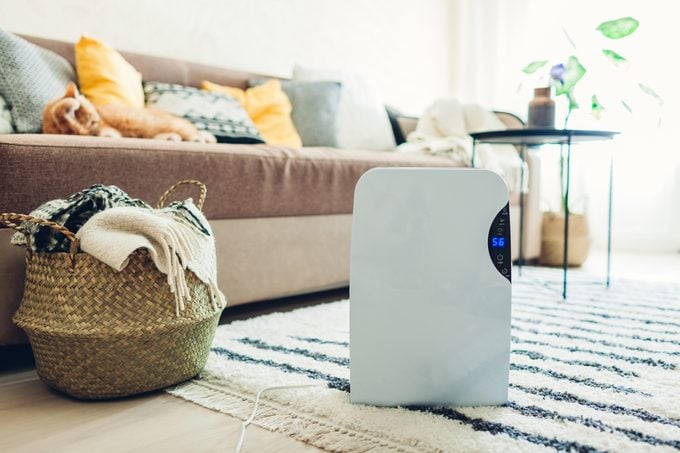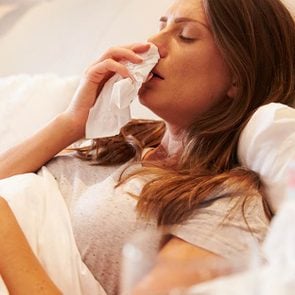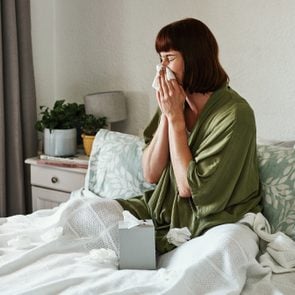6 Ways to Get Rid of Mold if You Have a Mold Allergy
Updated: Mar. 08, 2022
A mold allergy can be as devastating as seasonal allergies. Here's how to get rid of mold to help relieve your symptoms.
A mold allergy
If your sniffling and sneezing peaks during summer or early fall, or if you’ve that noticed your symptoms dovetail with that musty smell in your bathroom, you may be allergic to mold.
Seasonal allergies to pollen or ragweed and year-round allergies to pet dander and dust mites are way more common and tend to get more attention.
But for some people, the misery of allergy symptoms is caused by exposure to mold.
What is mold anyway?
You’ve likely encountered hairy patches of mold growing on foods that have overstayed their welcome. Ick! (Here’s what happens if you accidentally eat mold.)
But not all mold on food is bad. Some foods, like blue cheese, are even made with mold. And an allergy to mold is not a food allergy.
Mold also lives in the environment. In fact, there are at least 1,000 species of mold in the United States, but only around 80 of them can trigger allergic reactions if you’re susceptible.
The most common allergy-causing molds are Alternaria, Aspergillus, Cladosporium, and Penicillium, according to the American Academy of Allergy, Asthma, and Immunology (AAAAI).
Molds are microscopic fungi whose spores float through the air, like pollen. Some, like Alternaria, are considered outdoor molds, while others, like Penicillium and Aspergillus, can be found indoors in damp, humid areas.
Outdoor molds tend to be more common in summer and early fall, but indoor mold can cause allergy symptoms all year round unless you get rid of it.
“Mold allergy can be seasonal in the humid summer months and in the fall, when leaves and branches fall, as these times are associated with mold growth,” says Neeta Ogden, MD, an allergist and immunologist in Edison, New Jersey, and a spokesperson for the American College of Allergy, Asthma, and Immunology (ACAAI).
But outdoor mold can easily make its way indoors. It’s pretty easy for mold on fallen leaves to be tracked into your home if you don’t insist your guests take their shoes off. Airborne spores can even blow in the house if you leave your back door open.
(These hidden sources of mold in your home could be making you sick.)

Mold allergy symptoms
Not everyone is sensitive to mold, but if you are, you may develop symptoms if you inhale or touch mold or mold spores.
If you have allergies, your immune system reacts when it’s exposed to an allergen like mold, kick-starting a reaction that produces histamines. They, in turn, cause your symptoms.
“Mold allergy can present with typical respiratory allergy symptoms, such as cough, shortness of breath, or chest tightness, but sinus headache, pressure, and chronic nasal congestion can also be present,” says Dr. Ogden. “In severe cases, people can have more systemic symptoms, like sinusitis, fatigue, and just feeling ill.”
Don’t worry: inhaling mold won’t cause you to grow mold inside your body, says Karin Pacheco, MD, an allergist and associate professor in the division of environmental and occupational health sciences at National Jewish in Denver.
“Your immune system will move in and destroy the mold,” she says. “You may have an asthma attack, but you won’t inhale a cloud of mold that will now grow in your body.”
Do you have an allergy to mold?
Mold allergies aren’t as easy to diagnose as other allergies, says Dr. Pacheco.
Skin prick testing, which is commonly used to identify allergies, is an option. During these tests, a drop of diluted allergens is applied to the skin. Your doctor will then gently scratch or prick the allergen into your skin.
You’ll be closely observed to see if you react and develop raised, red, itchy bumps in the area where the allergen was applied.
Unfortunately, Dr. Pacheco says, this type of testing is not necessarily a slam dunk when it comes to mold.
“The testing extracts are made from mycelium in mold, but what you are actually exposed to are spores in the air,” she says. This is like comparing apples to oranges.
Results from blood tests that measure immunoglobulin E (IgE) antibodies offer another clue as to what’s causing your allergy symptoms, says Stephen I. Wasserman, MD, an allergist and immunologist in La Jolla, California, and a spokesperson for the AAAAI. If you are allergic to something, your immune system overreacts to it by producing these antibodies.
But this doesn’t provide a definitive diagnosis either.
“Testing can help confirm or deny a mold allergy, but in and of itself, it’s not a diagnosis,” Dr. Wasserman says. “There has to be a logical link between symptoms and exposure to something.”
If it’s fall and there are leaves on the ground and you can see and smell mold, that’s a logical link, he says.
“Geography changes things too,” Dr. Wasserman adds. “Mold season in New England is very different than the seasonality in New Mexico or California.”
Where mold grows
The good news, Dr. Pacheco says, is that getting rid of the mold in your home will improve your symptoms if you have a mold allergy. This starts with finding the source.
Indoor mold is found where there’s a water collection or contamination.
A good rule of thumb? “If it smells musty or moldy, it probably is,” Dr. Pacheco says.
If you smell it but don’t see it, consider hiring an industrial hygienist to do a walk-through to find the source. The American Industrial Hygiene Association (AIHA) can help you find a local expert.
Your next steps will be based on how much mold you actually have and where it lurks.
“Mold on your bathtub tiles is not a huge problem, but mold in the drywall behind your bathtub tiles may be a big and expensive problem,” Dr. Pacheco says.
If the moldy area is less than three feet by three feet, you can likely handle it on your own, the Environmental Protection Agency states. Larger areas may require you to bring in the pros.
How to get rid of mold
Once you get mold out, you want to keep it out. There are some steps you can take to reduce your chances of encountering mold that can trigger your allergies.
Air out damp and humid areas
One way to prevent bathroom mold is to avoid letting your shower run before you get in. It can build up humidity.
Try to air out your shower, laundry, and cooking areas—which can be damp and humid—with a fan or by opening a window, Dr. Ogden says.
Fix home leaks and treat visible mold fast
Fix any home leaks to avoid water accumulation that can provide a breeding ground for molds, says. Dr. Ogden.
Always hit visible mold early and hard. “Treat the first sign of mold aggressively in the bathroom using a little watered-down bleach, wearing a mask and gloves to do this,” she says.
Clean your washing machine
Yes, you need to clean the machine that cleans your clothes. The moist, warm, and dark environment is the perfect breeding ground for mold.
Here’s how to clean your washing machine and keep mold out.

Use a dehumidifier
Using a dehumidifier in areas with moisture and humidity can also keep things dry, Dr. Ogden adds.
Ideally, you want to keep the humidity between 30 and 50 percent all day, according to the Centers for Disease Control and Prevention.
Running your air conditioner also prevents mold growth because it moves cool air around the home and fighting humidity, says Dr. Wasserman.
Use HEPA filters
High-efficiency particulate air (HEPA) filters can help get mold and other allergens out of the air. HEPA filters are in whole-house air purifiers as well as portable air purifiers for mold.
“These filters trap particles, including pollen, mold, and bacteria,” Dr. Pacheco explains. “If you are concerned about particulate exposure, get a local HEPA unit that you can move from room to room.”
A HEPA filter for your vacuum is also a good idea. “It will pick up most of the stuff that lands on the floor, and if you are really allergic, this can reduce exposure to mold or other allergens,” she says.
Don’t buy a home mold kit
Whatever you do, don’t buy a home mold kit to identify the types of spores in your home, Dr. Pacheco says.
These are a waste of money. It doesn’t really matter what type of mold is in your home. What matters is getting it out, she says.
How to avoid outdoor mold
There are things you can do outside to reduce exposure to mold, Dr. Ogden says. If you’re raking fall leaves, wear a mask and gloves, and shower immediately after.
Keep your doors closed to prevent mold spores from blowing in, Dr. Wasserman says. And ask guests to take their shoes off so they don’t track mold in.
The American College of Allergy, Asthma, and Immunology suggests regularly clearing your gutters and making sure that drainage flows away from your home.
Check the AAAAI’s National Allergy Bureau keep tabs on mold and pollen counts. You can sign up for alerts, and when you see that mold counts are high, stay indoors.
Mold allergy treatment
Treatments such as allergy shots or immunotherapy help reduce mold allergy symptoms.
These shots gradually introduce an allergen to your immune system so it won’t launch an attack each time you encounter the allergy. Without your immune system mounting an attack, you won’t have those telltale allergy symptoms.
As with other allergies, trigger avoidance and treating the specific symptoms may also make a big difference in your quality of life, Dr. Wasserman says.
This may include using prescription or over-the-counter nasal sprays or antihistamines for sniffling and sneezing, eye drops for itchy eyes, or an inhaler for asthma.
Your allergist will work with you to find the most effective treatments for your mold allergy symptoms.



















